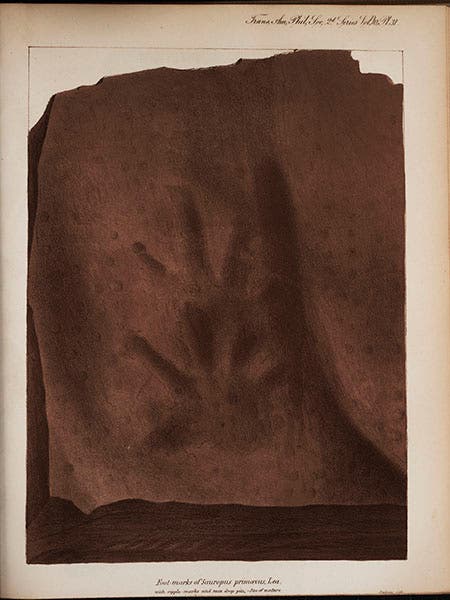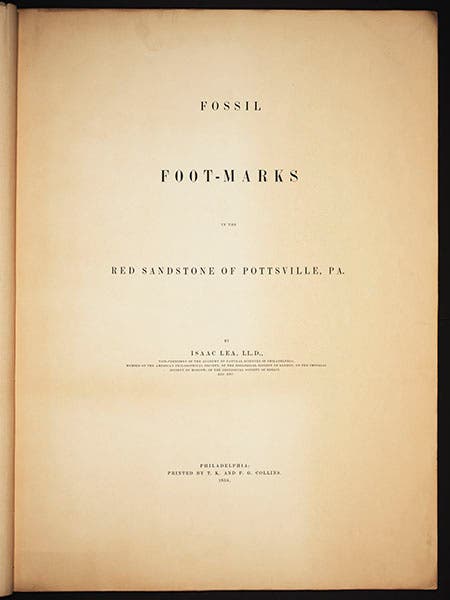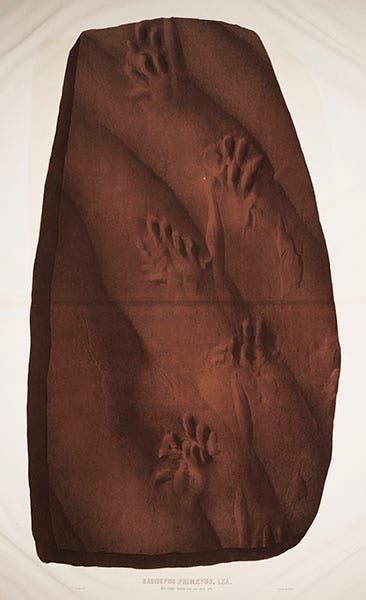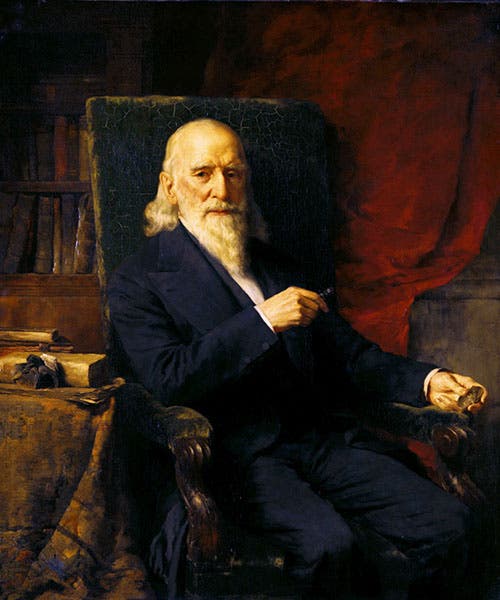Scientist of the Day - Isaac Lea
Isaac Lea, an American geologist, conchologist, and publisher, was born Mar. 4, 1792. Lea lived in Philadelphia and was known for his vast collection of fossil fresh-water shells. But his most spectacular find was a set of fossil footprints that he found in a slab of red sandstone outside Philadelphia. Lea believed that the prints were those of an early four-footed land animal (now called a tetrapod), and yet the rock seemed at the time to be from a formation that was too old for the remains of land animals.

Two fossil tracks, lithographed plate accompanying Isaac Lea, “On the fossil foot-marks in the red sandstones of Pottsville, Schuylkill County, Penna.,” Transactions of the American Philosophical Society, 1853 (Linda Hall Library)

Entire slab of fossil footprints in sandstone, lithographed plate accompanying Isaac Lea, “On the fossil foot-marks in the red sandstones of Pottsville, Schuylkill County, Penna.,” Transactions of the American Philosophical Society, 1853 (Linda Hall Library)
In 1853, Lea published a paper, “On the fossil foot-marks in the red sandstones of Pottsville, Schuylkill County, Penna.,” in the Transactions of the American Philosophical Society. The paper was accompanied by two colored lithographs, one showing a detail of two track-ways (second image), the other depicting the entire slab (third image).

Title page of Isaac Lea, Fossil Foot-marks in the Red Sandstone of Pottsville, Pa., 1855 (Linda Hall Library)
Lea apparently felt that the lithograph of the slab in his 1853 paper was too small. Consequently, in 1855, he re-announced his discovery, this time in a slim but very tall folio (fourth image), with the slab reproduced at life size. The plate is a lithograph, printed in two colors of reddish-brown, and it is just gorgeous, and really must be seen in person to be appreciated. We reproduce here the entire plate (fifth image), and a detail (first image). We displayed the lithographs from both publications in our 2013 exhibition, Crayon and Stone: Science Embraces the Lithograph, which is not available online.

Entire slab of fossil footprints in sandstone, in Isaac Lea, Fossil Foot-marks in the Red Sandstone of Pottsville, Pa., 1855 (Linda Hall Library)
We now know that the slab came from middle Mississippian rocks that date to 320-340 million years ago, and we know that Lea guessed correctly – they are some of the earliest tetrapod tracks known. The slab supposedly still survives, in the collections of the Academy of Natural Sciences in Philadelphia
Lea lived to be 94 years old. In 1884 or so, when he was 92, he sat for a portrait by Bernhard Uhle. The portrait is now in the National Portrait Gallery on the Mall in Washington, D.C. (sixth image).
Dr. William B. Ashworth, Jr., Consultant for the History of Science, Linda Hall Library and Associate Professor emeritus, Department of History, University of Missouri-Kansas City. Comments or corrections are welcome; please direct to ashworthw@umkc.edu.







